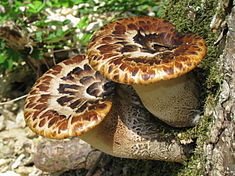- Polyporus squamosus
-
Polyporus squamosus 
Scientific classification Kingdom: Fungi Phylum: Basidiomycota Class: Agaricomycetes Order: Polyporales Family: Polyporaceae Genus: Polyporus Species: P. squamosus Binomial name Polyporus squamosus
(Huds.) Fr.Synonyms Species synonymy[1]- Agarico-pulpa ulmi Paulet
- Boletus cellulosus Lightf.
- Boletus juglandis Schaeff.
- Boletus maximus Schumach.
- Boletus michelii (Fr.) Pollini
- Boletus polymorphus Bull.
- Boletus rangiferinus Bolton
- Boletus squamosus Huds.
- Bresadolia caucasica Shestunov
- Bresadolia paradoxa Speg.
- Bresadolia squamosa (Huds.) Teixeira
- Cerioporus michelii (Fr.) Quél.
- Cerioporus rostkowii (Fr.) Quél.
- Cerioporus squamosus (Huds.) Quél.
- Favolus squamosus (Huds.) Ames
- Melanopus squamosus (Huds.) Pat.
- Polyporellus rostkowii (Fr.) P. Karst.
- Polyporellus squamatus (Lloyd) Pilát
- Polyporellus squamosus (Huds.) P. Karst.
- Polyporellus squamosus f. rostkowii (Fr.) Pilát
- Polyporus alpinus Saut.
- Polyporus caudicinus Murrill
- Polyporus dissectus Letell.
- Polyporus flabelliformis Pers.
- Polyporus flabelliformis Pers.
- Polyporus infundibuliformis Rostk.
- Polyporus juglandis (Schaeff.) Pers.
- Polyporus michelii Fr.
- Polyporus pallidus Schulzer
- Polyporus retirugis (Bres.) Ryvarden
- Polyporus rostkowii Fr.
- Polyporus squamatus Lloyd
- Polyporus squamosus f. michelii (Fr.) Bondartsev
- Polyporus squamosus f. rostkowii (Fr.) Bondartsev
- Polyporus squamosus var. maculatus Velen.
- Polyporus squamosus var. polymorphus (Bull.) P.W. Graff
- Polyporus ulmi Paulet
- Polyporus westii Murrill
- Trametes retirugis Bres.
Polyporus squamosus Mycological characteristics 
pores on hymenium 

cap is depressed
or offset
hymenium is decurrent 
stipe is bare 
spore print is white 

ecology is saprotrophic
or parasitic

edibility: edible
or inediblePolyporus squamosus is an basidiomycete bracket fungus, with common names including Dryad's saddle and Pheasant's back mushroom.[2] It has a widespread distribution, being found in North America, Australia, Asia, and Europe, where it causes a white rot in the heartwood of living and dead hardwood trees. The name "Dryad's saddle" refers to creatures in Greek mythology called Dryads who could conceivably fit and ride on this mushroom, whereas the pheasant's back analogy derives from the pattern of colors on the bracket matching that of a pheasant's back.
Contents
Taxonomy
The species was first described scientifically by British botanist William Hudson in 1778, who named it Boletus squamosus.[3] It was given its current name in 1821 by Elias Magnus Fries in his Systema Mycologicum.[4]
Description
This mushroom is commonly attached to dead logs or stumps at one point with a thick stem. Generally, the fruit body is 8–30 cm (3–12 in) across and up to 10 cm (4 in) thick. The body can be yellow to brown and has "squamules" or scales on its upper side. On the underside one can see the pores that are characteristic of the genus Polyporus; they are made up of tubes packed together closely. The tubes are between 1 and 12 mm long. The stalk is thick and short, up to 5 cm (2.0 in) long.[2] The fruit body will produce a white spore print if laid onto a sheet of paper. They can be found alone, in clusters of two or three, or forming shelves. Young specimens are soft but toughen with age. It is particularly common on dead elm and is also found on living maple trees.
Distribution and habitat
This organism is common and widespread, being found east of the Rocky Mountains in the United States and over much of Europe. It is also found in Australia and Asia. It commonly fruits in the spring, occasionally during autumn, and rarely during other seasons. Many mushroom hunters will stumble upon this when looking for morels during the spring as both have similar fruiting times, and this fungus can grow to a noticeable size of up to 50 cm (20 in) across.[5] It plays an important role in woodland ecosystems by decomposing wood, usually elm, but is occasionally a parasite on living trees. Other tree hosts include ash, beech, horse chestnut, lime, maple, planetree, poplar, and willow.[6]
Edibility and human uses
While P. squamosus is certainly not poisonous, it is generally not recognized as an edible mushroom unless the specimens are very young and tender. Cookery books dealing with preparation generally recommend gathering these while young, slicing them into small pieces, and cooking them over a low heat. Some people value the thick, stiff paper that can be made from this and many other mushrooms of the genus Polyporus. The mushroom's smell resembles watermelon rind.[2]
References
- ^ "Species synonymy for Polyporus squamosus (Huds.) Fr.". Index Fungorum. CAB International. http://www.speciesfungorum.org/Names/SynSpecies.asp?RecordID=186284. Retrieved 2010-05-28.
- ^ a b c Spahr DL. (2009). Edible and Medicinal Mushrooms of New England and Eastern Canada. Richmond, Calif: North Atlantic Books. pp. 131–35. ISBN 1-55643-795-1. http://books.google.com/books?id=nFZ-lwRXuNYC&lpg=PA131&dq=Polyporus%20squamosus&pg=PA131#v=onepage&q=Polyporus%20squamosus&f=false. Retrieved 2010-05-28.
- ^ Hudson W. (1778). Flora Anglica (2 ed.). p. 626.
- ^ Fries EM. (1821). Systema Mycologicum. p. 343.
- ^ Lonsdale D, Butin H. (1995). Tree Diseases and Disorders: Causes, Biology, and Control in Forest and Amenity Trees. Oxford [Oxfordshire]: Oxford University Press. pp. 170–71. ISBN 0-19-854932-6. http://books.google.com/books?id=p7tVCv2EiTgC&lpg=PA169&dq=Polyporus%20squamosus&pg=PA170#v=onepage&q=Polyporus%20squamosus&f=false. Retrieved 2010-05-28.
- ^ Schmidt O. (2006). Wood and Tree Fungi: Biology, Damage, Protection, and Use. Berlin: Springer. p. 199. ISBN 3-540-32138-1. http://books.google.com/books?id=lMXYJaWbO2YC&lpg=PA199&dq=Polyporus%20squamosus&pg=PA199#v=onepage&q=Polyporus%20squamosus&f=false. Retrieved 2010-05-28.
Gallery
External links
Categories:- Fungi of Europe
- Fungi of North America
- Polyporus
Wikimedia Foundation. 2010.





